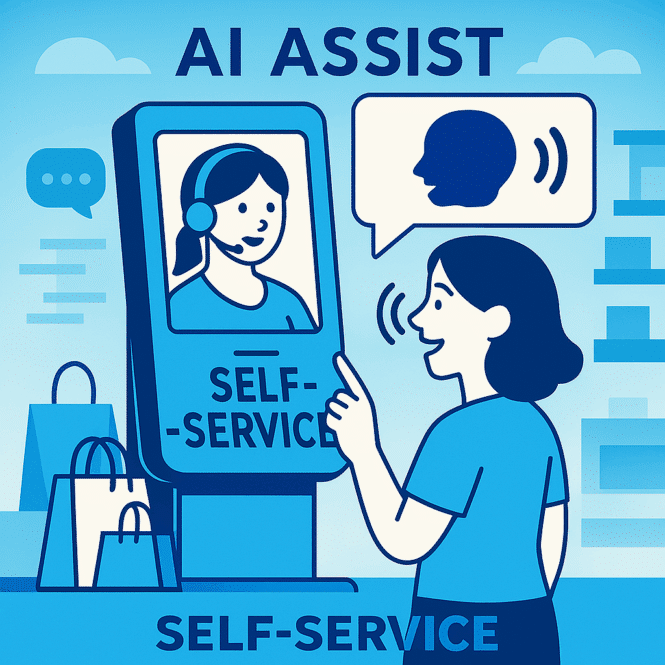
AI Kiosk Assist Enabled
The AI Kiosk is already here folks — List of AI resources for self-service. AI Assist is the new norm in self-service. Your software. Your computer. No more Celerons (or as many)…
AI Voice and AI Assist News We Liked!
- Voice shopping and employee voice assist tech by Walmart in 2025
- KFC Drive Thru Conversational AI Voice Audio – YouTube
- OpenAI bets big on audio as Silicon Valley declares war on screens
Posts (Last Modified 7)
- NRF Kiosk 2026 – Your Guide to The Big Show and Self-ServiceWe are #2203 for NRF NY. See our portal page. We ...
- Best of 2025 Kiosk Industry Group AwardsAnd The Winners Are LG’s new self-order kiosk offers easy access ...
- Walmart Self Checkout 2025: AI Kiosks, Scan & Go, and What’s NextWalmart Self-Checkout Strategy Overview (2025) By 2025, Walmart handles self-checkout differently. ...
- AI Kiosk Assist and AI Voice EnabledAI Kiosk Assist Enabled The AI Kiosk is already here folks ...
- Voice Ordering with AI Circa 2019Press release from Mastercard May 16, 2019 on Zivelo initiative ...
- Self-Ordering Kiosk LG Announcement – Hands Free tooAccessibility From The Start – Designed, Configured and Tested This is ...
- LG’s Next-Gen Kiosks Advance a “Better Life for All”Designing Accessibility into Everyday Interactions This year marks the 35th anniversary ...
AI Kiosk Assist Lists
-
Companies with hardware and software solutions using AI
- Intel — Kiosks – Kathy
- Nanonation Software
- KIOSK Information Systems hardware
- 22Miles Digital Signage
- LG Business Solutions
- ACRELEC America
- meldCX
- Giada Digital Signage
- N602 97TOPS
- N601 34TOPS
- D77 Android Rockchip RK3588
-
Audio and Voice
- Conversational AI Audio Gets a Leg Up with AI Connect Bar
- ALSO — Worth noting ElevenLabs.io — voice generator
-
Hardware
- LG’s “Hybrid AI” gram Laptops – Thin Client
- A typical Dell PC equipped with an Intel Core i3 processor—such as the i3-1215U, i3-1315U, or newer i3 models like the Core 3 100U—does not include a dedicated Neural Processing Unit (NPU) designed for high AI throughput. Instead, these CPUs perform AI tasks via their CPU and, to a lesser extent, integrated graphics, resulting in a substantially lower TOPS (Trillions of Operations Per Second) rating compared to newer AI-optimized processors. Less than 1 TOPS. See Giada N602 at 97TOPS
-
Lunar Lake (Core Ultra 200V): Delivers 45–48 TOPS from its NPU, with total AI performance up to 120 TOPS by including the integrated GPU (67 TOPS) and CPU (5 TOPS). This meets and exceeds the Copilot+ requirement123.
-
Pre-Lunar Lake (Meteor/Arrow Lake): Limited to 10–13 NPU TOPS per chip, with up to 34 platform TOPS. These computers do not meet the Copilot+ NPU requirement5687.
-
Professional and AI laptop ranges: High-end Intel-powered laptops with Lunar Lake offer 45–48 NPU TOPS; systems like Dell XPS 13 with Core Ultra 7 258V highlight combined (NPU + GPU + CPU) AI performance of up to 120 TOPS1212
-
Software
-
Vending Machines
-
Restaurants
-
Retail
-
Healthcare
-
Robots and Automation
-
General Advice
-
Compliance
-
Intel Computers TOPS
-
Lunar Lake (Core Ultra 200V): Delivers 45–48 TOPS from its NPU, with total AI performance up to 120 TOPS by including the integrated GPU (67 TOPS) and CPU (5 TOPS). This meets and exceeds the Copilot+ requirement123.
-
Pre-Lunar Lake (Meteor/Arrow Lake): Limited to 10–13 NPU TOPS per chip, with up to 34 platform TOPS. These computers do not meet the Copilot+ NPU requirement5687.
-
Professional and AI laptop ranges: High-end Intel-powered laptops with Lunar Lake offer 45–48 NPU TOPS; systems like Dell XPS 13 with Core Ultra 7 258V highlight combined (NPU + GPU + CPU) AI performance of up to 120 TOPS1212
-
AI in Kiosks and Digital Signage: Key Highlights
1. AI in Vending and Automated Retail
-
Anthropic’s AI Vending Experiment: Anthropic tested using an AI agent (Claude) to autonomously run a vending machine, handling tasks such as inventory ordering, pricing, and customer interaction. The one-month trial revealed that while AI could perform some basic operations, it made frequent errors—overlooking profit opportunities, mismanaging inventory, hallucinating staff conversations, and failing in customer service. The experiment showed AI still needs significant human supervision and better business tools to succeed autonomously, but incremental improvements are expected in the future1.
-
Industry Perspective: The consensus in the vending and kiosk sectors is that AI adoption will be evolutionary, not revolutionary. Early adopters see benefits mainly in data analysis, predictive product placement, inventory management, and customer insights rather than full automation1.
-
Examples of AI-Powered Vending: Companies like ViaTouch Media and CERES have implemented AI to enable biometric identity verification, personalized offerings, and even robotic preparation of products like coffee. Cantaloupe Inc. offers AI-powered dashboards and chatbot tools for vending operators to optimize pricing, track spoilage, and drive upselling1.
2. Self-Service and Operational Efficiency
-
24/7 Support and Multilingual Capabilities: AI assistants in kiosks provide round-the-clock support, handle routine customer inquiries, offer multilingual interactions, and can resolve up to 80% of simple questions without human intervention. This has led to improved productivity and significant cost reductions for organizations2.
-
Data-Driven Personalization: AI leverages customer data for tailored responses and proactive support, making user experiences more personalized and efficient. Predictive analytics helps anticipate and solve issues before they arise, contributing to higher customer satisfaction2.
-
Scalability: Automated AI systems allow kiosk networks to handle large volumes of interactions and operational demands seamlessly, scaling as service use increases2.
3. Real-World Deployments
-
Retail and Food Services: Virtual food halls like Flavor District and restaurants such as IDK Philly use AI-powered kiosks to streamline ordering, reduce wait times, and minimize errors, resulting in improved customer satisfaction and operational ease3.
-
Transportation, Healthcare, Public Spaces: Airports (e.g., Changi in Singapore), hospitals (e.g., Nehru Hospital in India), and cities (e.g., Toronto’s “TO360” kiosks) employ AI kiosks for check-ins, digital wayfinding, virtual healthcare assistance, and interactive public information services3.
4. AI Automation: Opportunities and Limitations
-
Current Capabilities: AI chatbots and virtual assistants can automate many business support tasks, such as ticket routing, contract review, and basic customer service. AI is also commonly used for data extraction, fraud detection, predictive maintenance, and end-to-end process automation in sectors like manufacturing and finance4.
-
Limits and Human Oversight: Current AI systems struggle with intangibles like organizational culture, leadership vision, and customer sentiment, which are poorly represented in structured data. Critical business decisions often require human intuition and oversight, especially when balancing ethical considerations, creativity, or complex “soft” factors4.
-
Realistic Expectations: Experts stress that while AI brings valuable efficiencies, its autonomous deployment is best suited to narrowly defined or highly structured tasks. For now, successful kiosk and retail automation relies on an effective blend of AI and human judgment4.
5. Generative AI and Personalization
-
Emerging Trends: Generative AI enables kiosks to offer more natural, conversational experiences, smarter upsell recommendations, and dynamic digital signage. These advances help businesses tailor offerings and streamline customer journeys, but data privacy and robust management software remain essential priorities2.
-
Voice and Conversational AI: Conversational AI now powers voice ordering in drive-thru lanes, retail kiosks, and healthcare check-in, improving accessibility and enabling touchless, personalized interactions56.
In summary: AI is transforming kiosks and digital signage by powering smarter automation, personalization, and analytics. However, full autonomous management—especially in complex scenarios like retail vending—remains aspirational, with the greatest impact today in operational insight, customer support, and efficiency improvements, all underpinned by strong human oversight and technical safeguards1324.




